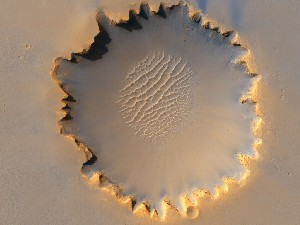 Victoria Crater on Mars, similar in size to the crater the
Victoria Crater on Mars, similar in size to the crater the
near-Mars asteroid 2007 WD 5 would have produced.
Credit: NASA/Mars Reconnaissance Orbiter
The possibility that a sizable asteroid would strike the planet Mars on January 30th temporarily raised the excitement level in the astronomical community to a pretty high level in the last couple of months. We were even toying with the idea of having a 3:00 AM Mars Bashing Party at Chabot that morning.
At one point astronomers had given odds of 1 in 25 that asteroid 2007 WD 5, newly discovered in November, would collide with Mars--which are astronomically great odds for this sort of thing. Alas, further observations refined our knowledge of the big rock’s trajectory, and the probability declined, hitting rock bottom (0.0%) by January 9th.
Why blog about a non-event? I see it as an opportunity to talk about big rocks bashing planets in general--specifically, the Earth.
While we haven't witnessed an event like this one (a big impact on a solid, Earth-like planet), we have examined the remains of past events, on Earth as well as other planets and moons—such as the hole in the Arizona desert called "Meteor Crater," an impact basin roughly the size of what might have been gouged out on Mars by 2007 WD 5. And compared to the asteroid that is believed to have caused the extinction of the dinosaurs, the Meteor Crater impact was a pipsqueak!
